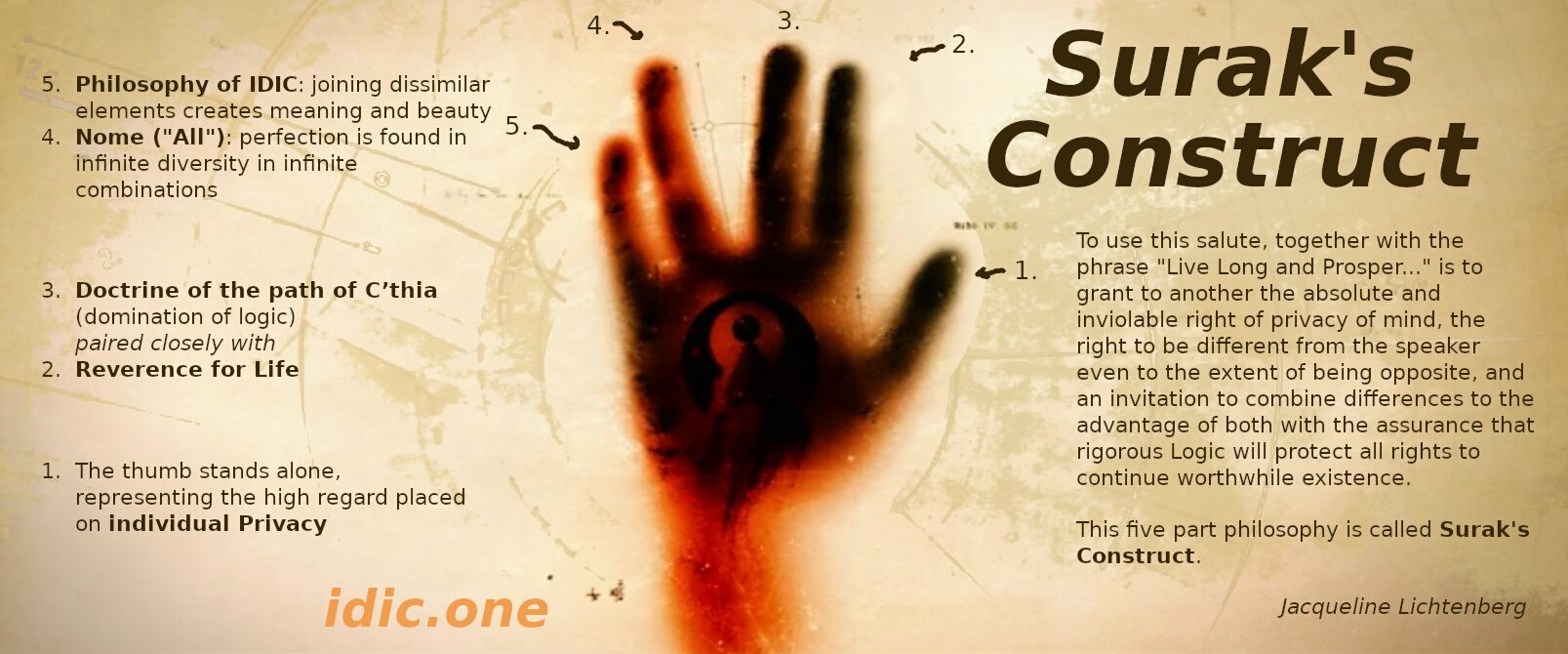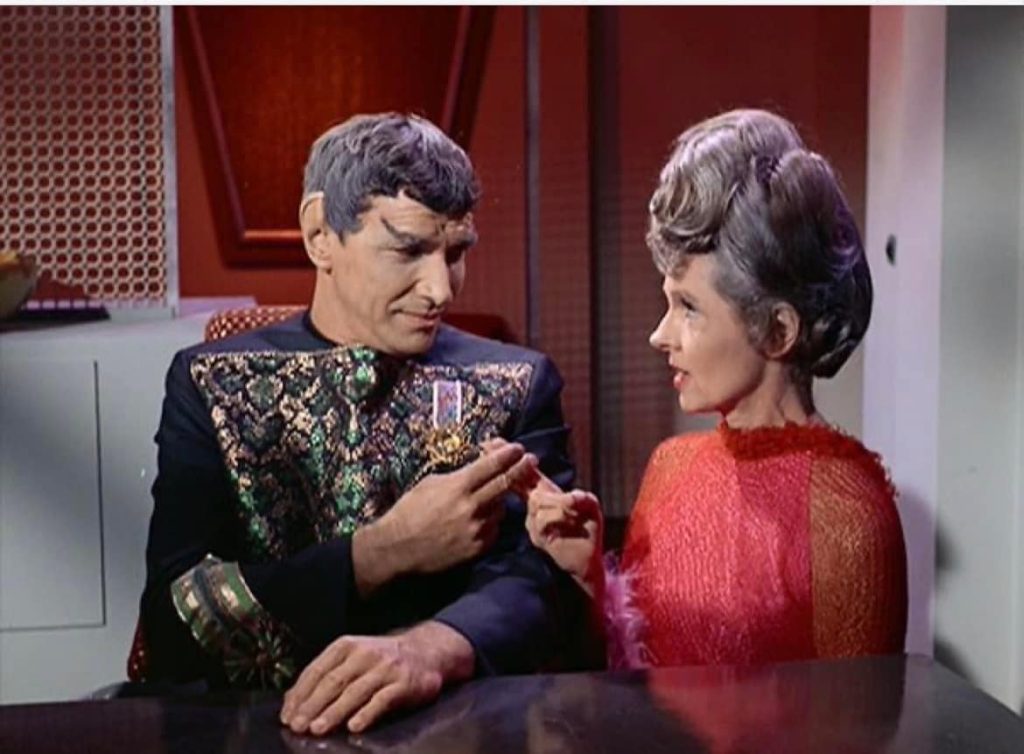
“It is a prime example of Vulcan efficiency to convey so much in such a brief salutation.”
– Spock
All of Vulcan philosophy rests on the five main concepts embodied in the Vulcan hand salute which is formed by holding the hand up, palm out, and separating the four fingers into a V with the two fingers on one side and two on the other side while holding the thumb separate. In this symbol, the ring finger represents the philosophy of Nome, meaning “All”, while the small finger represents the philosophy of the IDIC. The middle finger represents the Doctrine of the Domination of Logic and is paired closely with the index finger which represents the Vulcan Reverence-for-Life. The thumb stands alone, representing the high regard placed on individual privacy.
To use this salute, together with the phrase “Live Long and Prosper…” is to grant to another the absolutely inviolable right of privacy of mind, the right to be different from the speaker even to the extent of being opposite, and an invitation to combine differences to the advantage of both with assurance that rigorous Logic will protect all rights to continue worthwhile existence.
Let us now examine the parts of Surak’s Construct as this five part philosophy has been called.
The philosophy of NOME has been stated thus: An infinite variety of things combine to make existence worthwhile.
This is more than the IDIC and it includes the IDIC concept. The IDIC stands for the idea that the greatest joy in all creation is in the infinite ways that infinitely diverse things can join together to create meaning and beauty.
The philosophy of NOME emphasizes that infinite variety is essential to a worthwhile existence, while the IDIC emphasizes the joining of dissimilar elements to create meaning and beauty. The slight shift in emphasis is almost too subtle to capture in English words. Their interdependence is communicated by the close pairing of the two representative fingers.
The fingers are separated between NOME-IDIC and Logic-Reverence-for-Life because the philosophy of NOME-IDIC includes within itself both emotion and Logic. Or, put another way, both emotion and non-emotion. Within the IDIC concept such an “illogical” combination is not only permitted by praiseworthy. NOME-IDIC recognizes that emotion is a source of meaning, beauty, and worthwhileness in life.
However, Surak’s Construct asserts that for the sake of survival logic must be of greater influence in society (and within the individual), than emotion. Hence Logic, represented by the longest finger, is separated from the philosophy of “All” and paired with Reverence-for-Life, indicating that continued existence demands that logic rule over emotion but that almost equal with this tenet is the assertion that infinite variety must be present to make continued existence worthwhile.
The very philosophy of Vulcans compels a periodic confrontation with unleashed emotion. One of the prime goals of Surak’s Construct is to turn this ever present reminder of the power of unbridled emotion into a reinforcement of the dedication to logic. The adult Vulcan is aware of the surging emotions of the pon farr not only within themself but also in those around them. The inability to control emotion leads to a necessity to remove oneself for the duration of the condition. This is one reason why Surak places such value on Privacy.
The high regard for privacy was not an innovation of Surak but dates from a much earlier time when Vulcans discovered the literally painful effects of living together in large communities. They then developed telepathic shields and it soon because the height of rudeness to force one’s thoughts and feelings on another. The transgressor often met a swift and violent death.
Surak valued privacy for another and perhaps more important reason. Quite naturally, an individual’s highest regard is for themself. This is an ineradicable inheritance from bestial origins and transcends reason. The maintainance of self may be termed dignity. The right to inviolable privacy is essential in maintaining that dignity.
The one who attacks the dignity of the individual risks evoking unreasonable and utterly uncontrollable emotion. These reactions are so basic as to be beyond even the enormous control of the Vulcan disciplines. And a Vulcan roused in this fashion can be a very efficient machine of destruction. To ensure that such provocation should never exist, Surak made Privacy one of the cornerstones of his Construct. Under no circumstances is it justifiable to infringe on the dignity of another living being.
This attitude is perhaps the key to the Vulcan lack of a “sense of humor” in the human sense. Here, we may also find the motivation for acts of compassion. In Vulcans, such acts arise from the logical necessity to protect the dignity of others as one would one’s own. To fail to act to relieve suffering is to fail to acknowledge that the other individual is as important as oneself as oneself… that is, to fail to accord dignity.
Two other gestures are derived from the Vulcan hand salute. They, too, are symbols of a living philosophy in action.
The first gesture is the two-finger hand-hold that defines the spousal relationship. In Journey to Babel, Sarek held up his right hand with the index finger and the middle finger extended together. Amanda joined his extended fingers with hers held in the same position.
The index finger represents Reverence-for-Life and the middle finger represents Domination-of-Logic. These are the two dominant elements in the spousal union… procreation and preservation of life under the protection of a rigorous adherence to Logic. But note also what has been excluded. The thumb represents Privacy. There is no reserve of privacy in a spousal union. The NOME-IDIC Concepts are excluded because each must voluntarily surrender the right-to-be-extremely different which, in marriage, would be a source of grief, not joy.
The use of the gesture indicates an acknowledgement of Vulcan cultural values for society at large and for the inner life of the individual as well as the family unit. Thus it’s the tenderest gesture normally exchanged by partners, even more significant than a kiss, yet totally appropriate in public.
This view of the spousal relationship explains Amanda’s implication (Journey to Babel) that Vulcan husbands give orders and expect obedience as their rightful due. Such an authoritarian attitude toward females is totally at odds with everything else we know of Vulcan cultures; unless we assume it’s a mutual, voluntary agreement to abide by Surak’s Construct.
The second gesture is that of withdrawal into private contemplation. This is a position of the clasped hands with the index and middle fingers steepled, the thumbs folded and touching. This emphasizes Logic, Reverence-for-Life (suicide isn’t an option for a Vulcan), and Privacy. It excludes NOME-IDIC because within oneself one doesn’t retain sharp, contrasting differences for this is the road to insanity. One must create an internal unity upon which to base the Peace which is composed of individuals who are internally at peace. One’s first duty to society is one’s duty to oneself. The Vulcan’s need for that withdrawal into private contemplation is as intense as the human’s need to dream. Vulcan contemplation achieves a goal similar to human dreams… but is far more efficient as it uses a symbolic gesture integrated with a ritualistic set of mental exercises.
“Surak’s Construct”, Jacqueline Lichtenberg, “Pastaklan Vesla” issues #1 and #2; 1970
Editor’s Note: Mrs. Lichtenberg’s treatise on the Vulcan Language, theories on cultural behavior, commentaries and her Vulcan Kraith series can be found on her Kraith website. All opinions expressed by Mrs. Lichtenberg are not necessarily those of the editor.

